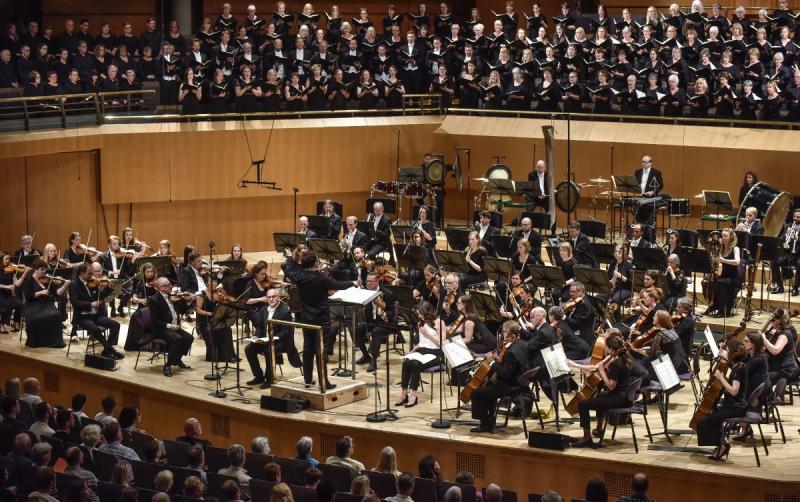The Anvil, Royal, Purves, BBCPO, Gernon, Bridgewater Hall, Manchester - disturbing, baffling and moving | reviews, news & interviews
The Anvil, Royal, Purves, BBCPO, Gernon, Bridgewater Hall, Manchester - disturbing, baffling and moving
The Anvil, Royal, Purves, BBCPO, Gernon, Bridgewater Hall, Manchester - disturbing, baffling and moving
This commemoration of the Peterloo Massacre is the kind of art that Manchester loves

Two hundred years ago next month, an assembly of around 60,000 people gathered on St Peter’s Fields in Manchester to protest about their lack of political representation. Speakers addressed the crowd, bands played and banners were carried.
The local magistrates didn’t like it and gave orders for the crowd to be dispersed by the mounted yeomanry, backed up by the hussars, who drew their sabres and charged. Eighteen people were killed and hundreds injured. That was the "Peterloo Massacre", named after the Battle of Waterloo, only four years before. The centre of its site became that of the Free Trade Hall, whose very name perpetuated an historic and allied, Manchester-inspired campaign.
Peterloo has become a potent symbol in Manchester history, and this year’s Manchester International Festival, the BBC Philharmonic and Radio 3 commissioned poet Michael Symmons Roberts and composer Emily Howard (pictured below) to commemorate it in a major new work for soloists, choirs and orchestra.
 The Anvil received its world premiere last night. It’s an ambitious 45-minute cantata, seeking not only to tell the story but also to convey a "what-would-it-have-been-like-if-you-were-there" impression.
The Anvil received its world premiere last night. It’s an ambitious 45-minute cantata, seeking not only to tell the story but also to convey a "what-would-it-have-been-like-if-you-were-there" impression.
Its construction is intricate, incorporating an idea of literally weaving words that evoke the event and its background (inspired by the fact that so many of those present or injured were described by the role of "weaver"). Michael Symmons Roberts constructed a giant grid of pregnant words that are assembled, dismantled and hurled into the mix, creating the effect of an unpredictable throng, with its slogans and would-be speakers, that must have been part of the reality of the day. As Emily Howard said afterwards: "If you were there you wouldn’t have heard anything most of the time – just snippets."
So that element in the soundworld was intentional. At the same time there is a narrative element, as Symmons Roberts’s seven-paragraph The Stones of Peterloo, picturing the scene, the event and the aftermath, is overlaid on it and interspersed with it.
This brings the more dramatic side of the story to the fore. Howard builds huge vocal-instrumental crashes, roars and surges, ratcheting up the tension as we know the fatal charge is coming, making her singers cry out their demands and the pulse of the music accelerate. There was almost an element of the Jaws film score about it – and with the greatest climax came a sound truly like that of a crowd in fear; and then there was the horrific peace that follows every bloodbath, with just the repeated intoning of the word "Suffrage", like an agonized prayer, still to be heard.
Among the most vivid elements in this soundtrack to the story was the earlier, slow tread of a procession, with hymn-like strains emerging from the choirs, culminating in a full-throated rendering of Tallis’s Canon tune – only itself to be disrupted. This has its roots in the historical evidence, too: the agitators of the day wrote polemical new words to the tunes of hymns everyone knew.
 Kate Royal (pictured right) was assigned a role that included much of the narrative part of Symmons Roberts’s poem; Christopher Purves represented the various male protagonists of the event, and more … finally including a cold, Sprechstimme-style description of the injured and their wounds.
Kate Royal (pictured right) was assigned a role that included much of the narrative part of Symmons Roberts’s poem; Christopher Purves represented the various male protagonists of the event, and more … finally including a cold, Sprechstimme-style description of the injured and their wounds.
The last word – unaccompanied soprano solo – is Symmons Roberts’s last vivid, but unsettling, summary of the heritage of Peterloo: "A piece of grit lodged in a tooth". (The title The Anvil, incidentally, simply refers to the approximate shape of the site’s ground-plan on the map).
This work’s performance was a disturbing, slightly baffling but ultimately moving experience, sometimes confusing as so much was immersed in a jumble of sounds, albeit intentionally so. It’s the kind of thing Manchester loves, as it’s art that’s special to the city and unites it in a sense of its own place in history. But it probably would be difficult to make it travel.
Ben Gernon’s sure hand on the tiller brought confident singing from the combined forces of the BBC Singers, Hallé Choir, Hallé Youth Choir and Hallé Ancoats Community Choir, and from an executant point of view all present deserve credit.
rating
Share this article
The future of Arts Journalism
You can stop theartsdesk.com closing!
We urgently need financing to survive. Our fundraising drive has thus far raised £49,000 but we need to reach £100,000 or we will be forced to close. Please contribute here: https://gofund.me/c3f6033d
And if you can forward this information to anyone who might assist, we’d be grateful.

Subscribe to theartsdesk.com
Thank you for continuing to read our work on theartsdesk.com. For unlimited access to every article in its entirety, including our archive of more than 15,000 pieces, we're asking for £5 per month or £40 per year. We feel it's a very good deal, and hope you do too.
To take a subscription now simply click here.
And if you're looking for that extra gift for a friend or family member, why not treat them to a theartsdesk.com gift subscription?
more Classical music
 Scott, Irish Baroque Orchestra, Whelan, RIAM, Dublin review - towards a Mozart masterpiece
Characteristic joy and enlightenment from this team, but a valveless horn brings problems
Scott, Irish Baroque Orchestra, Whelan, RIAM, Dublin review - towards a Mozart masterpiece
Characteristic joy and enlightenment from this team, but a valveless horn brings problems
 Classical CDs: Voice flutes, flugelhorns and froth
Baroque sonatas, English orchestral music and an emotionally-charged vocal recital
Classical CDs: Voice flutes, flugelhorns and froth
Baroque sonatas, English orchestral music and an emotionally-charged vocal recital
 Kanneh-Mason, Britten Sinfonia, Shave, Milton Court - a grin and a big beaming smile
A pair of striking contemporary pieces alongside two old favourites
Kanneh-Mason, Britten Sinfonia, Shave, Milton Court - a grin and a big beaming smile
A pair of striking contemporary pieces alongside two old favourites
 theartsdesk at the New Ross Piano Festival - Finghin Collins’ musical rainbow
From revelatory Bach played with astounding maturity by a 22 year old to four-hand jazz
theartsdesk at the New Ross Piano Festival - Finghin Collins’ musical rainbow
From revelatory Bach played with astounding maturity by a 22 year old to four-hand jazz
 First Person: Manchester Camerata's Head of Artistic Planning Clara Marshall Cawley on questioning the status quo
Five days of free events with all sorts of audiences around Manchester starts tomorrow
First Person: Manchester Camerata's Head of Artistic Planning Clara Marshall Cawley on questioning the status quo
Five days of free events with all sorts of audiences around Manchester starts tomorrow
 Goldscheider, Brother Tree Sound, Kings Place review - music of hope from a young composer
Unusual combination of horn, strings and electronics makes for some intriguing listening
Goldscheider, Brother Tree Sound, Kings Place review - music of hope from a young composer
Unusual combination of horn, strings and electronics makes for some intriguing listening
 theartsdesk Q&A: composer Donghoon Shin on his new concerto for pianist Seong-Jin Cho
Classical music makes its debut at London's K-Music Festival
theartsdesk Q&A: composer Donghoon Shin on his new concerto for pianist Seong-Jin Cho
Classical music makes its debut at London's K-Music Festival
 Helleur-Simcock, Hallé, Wong, Bridgewater Hall, Manchester review - moving lyricism in Elgar’s concerto
Season opener brings lyrical beauty, crisp confidence and a proper Romantic wallow
Helleur-Simcock, Hallé, Wong, Bridgewater Hall, Manchester review - moving lyricism in Elgar’s concerto
Season opener brings lyrical beauty, crisp confidence and a proper Romantic wallow
 Kohout, Spence, Braun, Manchester Camerata, Huth, RNCM, Manchester review - joy, insight, imagination and unanimity
Celebration of the past with stars of the future at the Royal Northern College
Kohout, Spence, Braun, Manchester Camerata, Huth, RNCM, Manchester review - joy, insight, imagination and unanimity
Celebration of the past with stars of the future at the Royal Northern College
 Jansen, LSO, Pappano, Barbican review - profound and bracing emotional workouts
Great soloist, conductor and orchestra take Britten and Shostakovich to the edge
Jansen, LSO, Pappano, Barbican review - profound and bracing emotional workouts
Great soloist, conductor and orchestra take Britten and Shostakovich to the edge

Add comment